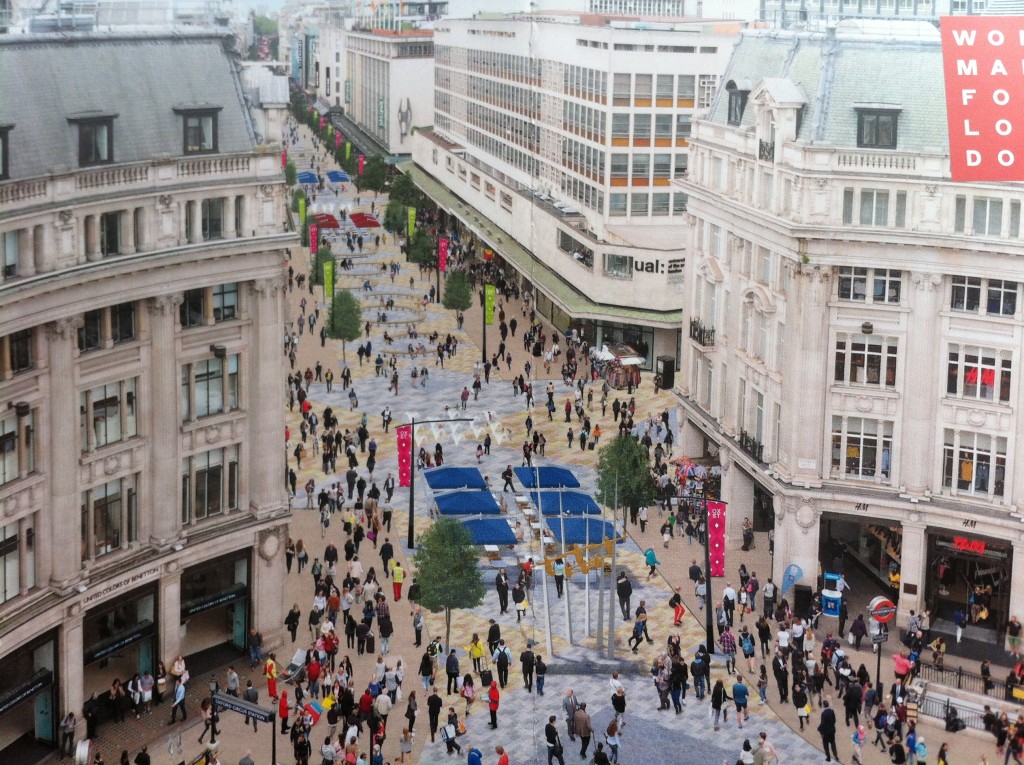Don’t breathe in Oxford Street
Caption: An image of a traffic free Oxford Street from one of Labour’s 2016 Mayoral candidates, Christian Wolmar.
David Carslaw’s paper at the June 2014 London Air Quality Network conference on “Frontiers in Air Quality Science” (http://www.londonair.org.uk/london/asp/LAQNSeminar/) reported high levels of NO2 levels in Oxford Street (in 2013) with an annual mean of 134 μg/m3, 1568 hours > 200 μg/m3 and a maximum of 489 μg/m3. Dr David Carslaw is a researcher in urban air pollution at King’s College, London, Environmental Research Group. The EU standard, based on WHO guidelines, is an annual mean of no more than 40 μg/m3 and maximum of 200μg/m3 for no more than 18 hours per year. For WHO guidelines see: http://whqlibdoc.who.int/hq/2006/WHO_SDE_PHE_OEH_06.02_eng.pdf
So what’s the problem? To quote Carslaw these were the “highest annual mean concentration and most hourly NO2 exceedances in the World?”. Reasons given on King’s College London Air Quality Network website are:
“1.The street is embedded in the centre of a very large source of NOx i.e. London.
2. It is completely dominated by diesel vehicles (buses/taxis) and has among the highest flow of buses of anywhere in the UK.
3. A large fraction of the bus fleet uses technology based on CRTs (Continuously Regenerating Trap) and similar technologies that deliberately produce increased emissions of NO2, as described above.
4. It is a street canyon whose orientation also serves to maximise concentrations. Street canyon locations are not as well-ventilated as open locations and this tends to result in increased concentrations.”
Source: http://www.londonair.org.uk/london/asp/news.asp?NewsId=OxfordStHighNO2
NB NOx is a generic term for the nitrogen oxides NO and NO2 (nitric oxide and nitrogen dioxide). NOx reacts with ammonia, moisture, and other compounds to form nitric acid vapour. Small particles can penetrate lung tissue and damage it. Inhalation of such particles may cause or worsen respiratory diseases, such as emphysema or bronchitis and may aggravate existing heart disease.
µg/m3 is a measure of an air pollutant and is in micrograms (one-millionth of a gram) per cubic metre air.
So what’s the answer: currently don’t visit Oxford Street unless there is a bus strike on. When buses (and taxis) dominate then don’t breath in. It is ironic that traffic in Oxford Street is regulated by Transport for London who have promotes diesel engined buses and taxis.
The mid-term answer is to pedestrianize the whole street and provide a people mover for the old, slow and tired or those burdened with shopping, or those who just want a ride. A people mover is modern jargon (always use many words instead of one) for a tram, Ken Livingstone floated this idea a number of times when he was mayor (2000-2008) and in his failed campaign for mayor in 2012. But Westminster Council opposed his proposals.

